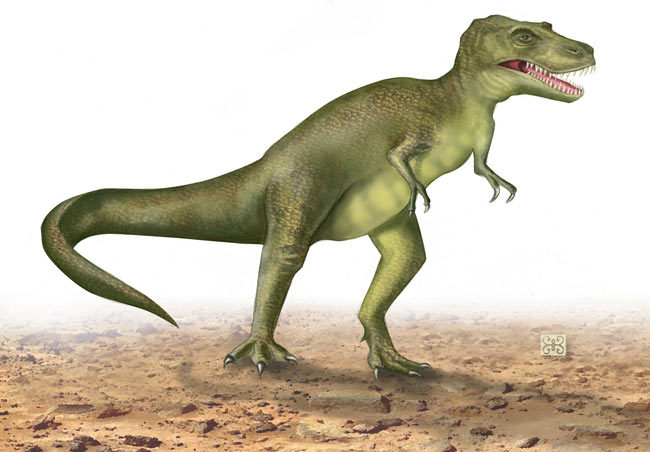Final Word? T. Rex Indeed a Ferocious Killer

Was Tyrannosaurus rex a fearsome hunter, or merely an opportunistic scavenger? By looking at both potential rivals and prey of the ancient carnivore, scientists now have evidence that it had to indeed have been a fierce killer.
One look at the giant, knife-like teeth of T. rex and there might be little doubt this titan hunted for its meals. Still, in the modern day, lions often get their meals by taking prey from others, such as antelopes downed by hyenas. As such, researchers have argued over whether T. rex was more thief than hunter. Those who suggest it was a scavenger point at its puny arms, useless for hunting, as well as what seems to have been a sensitive nose, helpful for tracking down rotting corpses. Others who claim it was a killer cite its powerful bite and impact-resistant teeth.
Instead of trying to figure out how T. rex might have eaten just by looking at its bones, scientists analyzed both the plant-eating victims the carnivore might have dined on and the smaller rivals it might have competed with for meals. All in all, they looked at 18 herbivores, such as hard-headed pachycephalosaurs and duck-billed hadrosaurs, and 10 competitors, such as Velociraptor and two-legged Troodon.
The researchers predicted that nearly half of all the herbivore prey likely eaten by T. rex weighed between 120 and 190 pounds (55 and 85 kilograms). Based on how abundant smaller predators were at the time, the scientists calculated that collectively they could have covered up to 60 times more ground daily than larger, and slower, T. rex. Given these findings, these competitors would have quickly consumed the carcasses of smaller prey. At the same time, larger carcasses would have been very rare and heavily fought over, making them unreliable as meals.
As such, researcher Chris Carbone, a carnivore ecologist at the Zoological Society of London, and his colleagues reasoned that T. rex and other extremely large carnivorous dinosaurs could not have lived solely as scavengers — they would have starved to death if they did. Rather, the researchers suggest they primarily hunted large prey, much as many large mammalian predators do today. [25 Amazing Ancient Beasts]
"The costs of hunting for this species must have been high," Carbone told LiveScience. "Given this, did it act like so-called 'sit-and-wait' predators, first hiding, then the chase with a sudden burst of speed, and then the kill, like a lion? Or did it gradually chase them over long distances to the point of exhaustion like a wild dog? I suspect the former, but it would be interesting to develop arguments based on biomechanics and energetics to see if one option seems favored over the other."
An understanding of extremely large predatory species such as T. rex could yield new insights into the evolution of predatory behavior.
Sign up for the Live Science daily newsletter now
Get the world’s most fascinating discoveries delivered straight to your inbox.
"After the extinction of the dinosaurs, mammalian carnivores never exceeded a ton, as far as we know," Carbone said. "So the idea that T. rex survived as a predator at about five to seven times the size of the largest mammalian predator means we need to learn more about how this species coped with its size and the fact that it was feeding on other large potentially rare dinosaur species."
Carbone and his colleagues detailed their findings online Jan. 25 in the Proceedings of the Royal Society B.











